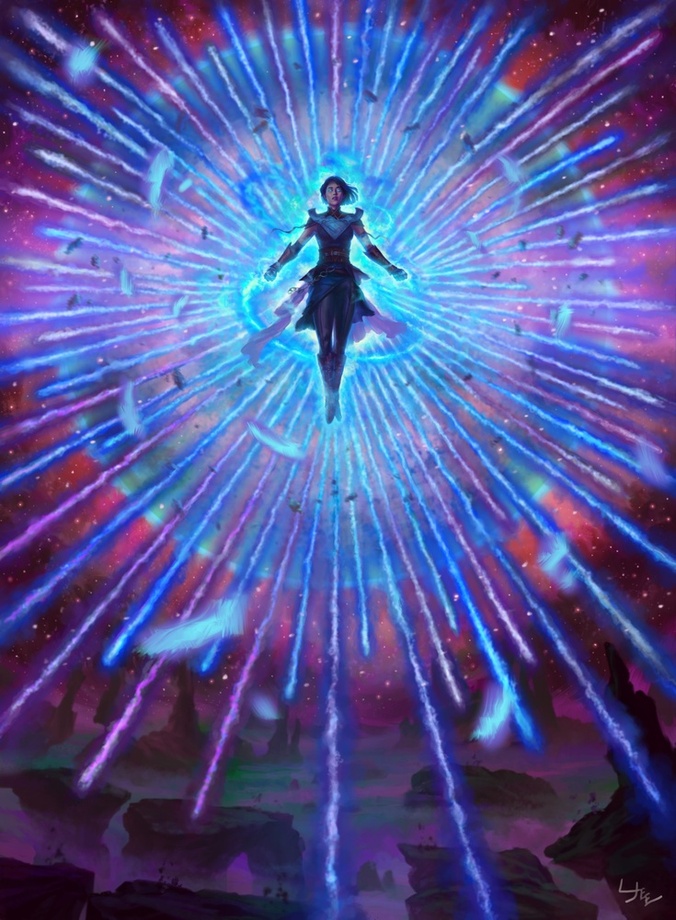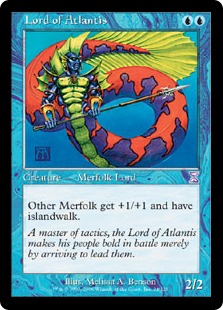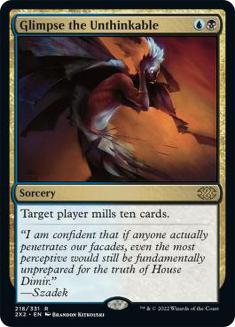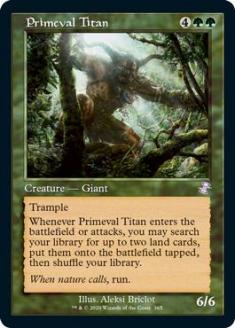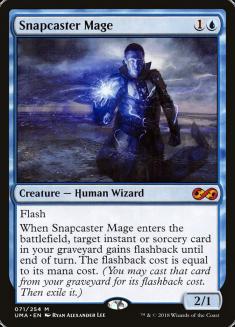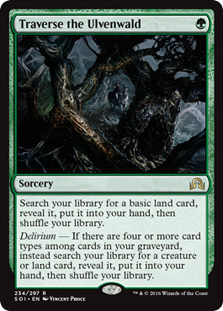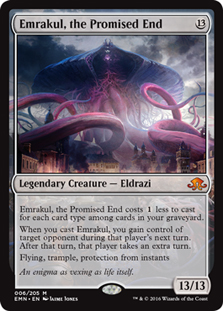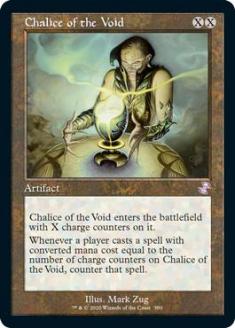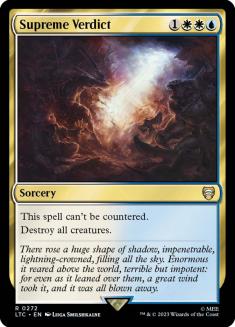Modern Faces the “Legacy Effect”
Predicting the Modern metagame has become a challenging task. When the format had a cheaper barrier to entry and the best decks were obvious, it took very little effort to prepare for a competitive tournament. Now, the cost barrier has created a “Legacy effect,” where the average competitor has no interest in dropping a few thousand dollars to change their deck up. In every eternal metagame analysis article I’ve written, I’ve dedicated a chunk to poking fun at that constant. Cost defined in-person metagames then and will continue to do so. This becomes evident the moment you walk around a tournament hall and see players wielding ancient relics they have been using for years.
The first round of SCG Dallas, I faced Mono-Blue Merfolk. This player whooped me in an easy 2-0 sweep. In the next two rounds I played against Dimir Mill and Amulet Titan, further painting the metagame prediction travesty that is live play.
For an avid control player, preparing for a Modern event has historically been impossible. The limited sideboard slots and the narrow disruption created many bad matchups. Since the release of superior blue and white cards, that problem doesn’t hold down a deck like Azorius Control anymore. Now, the responses summoned by the control player are powerful enough to take on a dozen different decks, bringing some reprieve to the heroes at least. This tournament where Mono-Blue Merfolk stomped me ended in the Top 8, where I fell to a classic Jund deck. Great result overall, but the number of different decks I played against was staggering.
Live and Online Metagames
Beyond the Legacy-esque price barrier, another aspect prevents players from switching decks. The variety of choices of Modern can all win at impressive rates, especially in live events. With the online metagame, players are mostly on the grind and play much more than your average tournament attendee. They will switch decks more often, suffering the financial burden, or use the various rental services for a flat fee. That choice and dedication creates a different dynamic for Magic Online (MTGO) players and will quickly push the best deck to the top. When you pull up in-person results, it looks like someone tossed in the best decks from the last decade and picked one at random to win. People play decks they are comfortable and experienced with, resulting in their continued Modern success.
With the diverse paper metagame created by cost barriers and comfort level, preparing for SCG CON Syracuse can be difficult. Control, Azorius and Four-Color, is so powerful that the card choice dilemma is not as crippling for fans of the archetype. Control lists continue to remain a solid constant over the last few months, with few modifications made to their core structures. Some fans of Azorius Control still enjoy Snapcaster Mage for some reason, while I have retired my set to my collection binder.
Both camps will find success with different supporting spells, because of the powerful common staples we all play. Four-Color Control (Yorion) is in the same boat, with some now showcasing a Traverse the Ulvenwald package and a maindeck Emrakul, the Promised End. Any way you cut it, the cards in these two decks are powerful enough to handle the pet decks of every opponent who shows up in Syracuse this weekend.
Target: Four-Color Control (Yorion)
Regardless of how diverse the metagame is, there will always be a best deck to prepare for. We cannot ignore that Four-Color Control (Yorion) is the accepted top dog of Modern, even though it will not breach more than 10% of the in-person metagame at any given tournament. I played against it in my Top 12 elimination match in SCG Dallas and that was the only time I faced it in the entire tournament. This matchup has the perception of being difficult to win, as many of my colleagues have condemned Azorius Control back down to underdog status. I have explained my strategy to beat Four-Color Control (Yorion) to friends and they responded with immediate disbelief. I will go over that same exact strategy here, as well as how I defend against an unpredictable metagame, with my weapon of choice for the weekend.
Beating Four-Color Control (Yorion) is not as challenging as the masses make it out to be. Azorius Control (Kaheera) has many of the cards that outclass the opposing control deck and often put the game out of their reach. The biggest edge is the spell quality, with Archmage’s Charm providing double the total countermagic of the competition. This makes a huge difference as the game continues to go long and the spell quality begins to dwindle. Both decks have spells that merit immediate disruption, but Azorius Control (Kaheera) has more opportunity to do so with the current setup.
The Power of Blue
In the blue realm, Archmage’s Charm is not the only advantage. Jace, the Mind Sculptor and Teferi, Hero of Dominaria will slam the door shut if they are not promptly removed. Each deck has planeswalkers, but Azorius Control (Kaheera) has the stronger combination in this particular matchup. As terrifying as Wrenn and Six can be, it is harmless in comparison to the juggernauts on the other side of the battlefield. Especially after sideboard, the planeswalkers of Four-Color Control (Yorion) are much easier to remove than the more expensive options in Azorius Control (Kaheera). This matchup turns into a battlefield-control slugfest, highlighting these differences if played correctly.
The new variation of Four-Color Control (Yorion) worried me some with their maindeck Emrakul, the Promised End. My nerves calmed some after I finally was able to make use of Chalice of the Void, a card that previously just stopped Unholy Heat and Abundant Growth. Now, with an extra victim to claim, it has become a powerful Game 1 card. Even in the sideboarded games, we know Veil of Summer is coming in, so the effectiveness of Chalice of the Void continues to pay dividends. The natural combatant to Veil of Summer, our Teferi, Time Raveler, has been enough to save me from this hellish card over the years. With both defensive mechanisms, my confidence against that mistake of a card continues to grow.
Control Mutuals
Many of the other cards in Four-Color Control (Yorion) are similar to those in Azorius Control (Kaheera). Solitude is a four-of staple for each deck, though it does not do much against the deck without creatures. Prismatic Ending is the one card in the matchup that has extended range in Four-Color Control (Yorion), mainly because of the additional color source. It can hit Jace, the Mind Sculptor and The Wandering Emperor, but that is about it. From the Azorius Control (Kaheera) side, it can hit Wrenn and Six and Teferi, Time Raveler, not the shabbiest of outcomes. The removal from Four-Color Control (Yorion) will have weaker outcomes in general, based on the instant-speed nature that Azorius Control (Kaheera) operates from.
The Control Semi-Mirror
These side-by-side comparisons paint a picture of the Four-Color Control (Yorion) versus Azorius Control (Kaheera) matchup. It is important to analyze and discuss this, to develop a plan to close the matchup gap. With the advantages that Azorius Control (Kaheera) has, the matchup in the dark is close to 50/50; however, I have made controversial sideboarding decisions that resulted in my continued success against it. The obvious sideboard cards come in, which include Aether Gust, Mystical Dispute, Shark Typhoon, and Dovin’s Veto. These are accepted champions of this matchup, a pile of blue disruption to prevent their spells from resolving.
Rest in Peace
Surprisingly to most, the best card in the sideboarded games continues to be Rest in Peace, scoffing aside. I first stumbled across this solution when my opponent dropped an Emrakul, the Promised End against me at SCG CON Dallas. That desperation Eldrazi did not defeat me then, but it did make the game very close. I had three more Emrakul, the Promised Ends resolve against me in that tournament and I only lost one of those games. This play still brought me close to defeat a couple of times, so I thought about the difficulty they would have resolving it against a Rest in Peace. Not only has that worked wonders since, it also disrupts other elements Four-Color Control (Yorion) relies on to win the control mirror.
Wrenn and Six is a complete dud in the face of Rest in Peace. This planeswalker can cause mayhem if left unchecked, and leaving in four copies of Prismatic Ending felt terrible. I relied on the one Celestial Purge and some Aether Gusts to provide additional insurance against it. This was not a bad strategy, but creating that collateral damage with Rest in Peace has been a godsend. Each time I resolve it, an aura of confusion surrounds my opponent until they see the writing on the wall. Traverse the Ulvenwald is embarrassing, Wrenn and Six is not functional, and Emrakul, the Promised end will not see the light of day. Some Four-Color Control (Yorion) decks even run Eternal Witness, creating the ultimate feel-bad when the silly two-cost enchantment hits the battlefield.
The “Doom Blade” Argument
As with any solution that is a permanent, Rest in Peace can be easily removed. This takes us back to the Doom Blade argument, applying that equation to anyone who says a nonblack creature is good. My Four-Color Control (Yorion) opponents often sideboard out some copies of Prismatic Ending, leaving them only with those remaining and Teferi, Time Raveler. Rest in Peace can also arrive later in the game and have a devastating effect on their dreams of casting the one good card against you, Emrakul, the Promised End. Sideboard in Rest in Peace with the usual package listed earlier, take out a bunch of removal depending on the version, and enjoy victory over defeat.
Other Matchups
Many of the other matchups in the wild west of Modern are under control. I mentioned that Mono-Blue Merfolk whooped me, and I am fine with that. There are some decks that require a complete remodel to win against, and the sacrifice Azorius Control has made is generic aggro. Decks that swarm the battlefield with a ton of creatures can be a problem since we are now only playing two copies of Supreme Verdict.
Upping the number played will increase matchup win percentage against little creatures, while hurting most of the others. It is either the card necessary to have a chance at winning, or a liability that prompts you to question why it was included. Cards this polarizing describe Azorius Control during its low years in Modern, only winning when it drew the correct half of its deck against the correct matchup.
A Two-Color Deck’s Golden Age
With ridiculously powerful disruption like Counterspell, Chalice of the Void, Prismatic Ending, Solitude, and March of Otherworldly Light, Azorius Control can now take on 90% of the metagame. It may not be fully favored against each deck, but it does have game against all of them. Aether Gust, Mystical Dispute, Celestial Purge, and Rest in Peace also receive some credit for the success of Azorius Control.
It is still hard to believe that Aether Gust answers uncounterable Primeval Titans, halts creatures from Mono-Red Aggro, and puts a Wrenn and Six that was close to its ultimate on the owner’s library. There are many other applications for this single piece of disruption, and this holds true for the other mentioned cards. The range each spell has is why Azorius Control has entered its Golden Era in competitive Magic. Thanks to some favorable bannings and unbannings, as well as some powerful printings and reprintings, fans of this archetype continue to enjoy tournament success.

